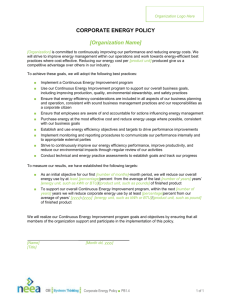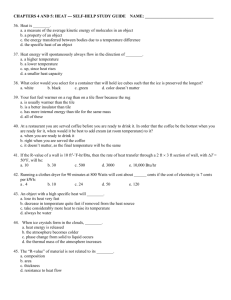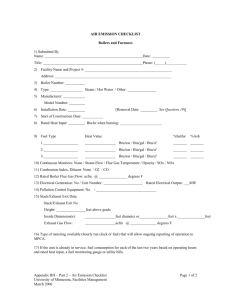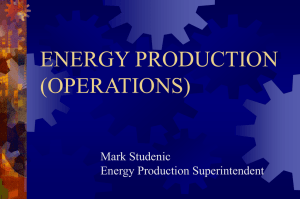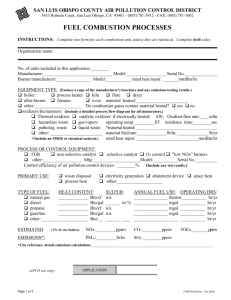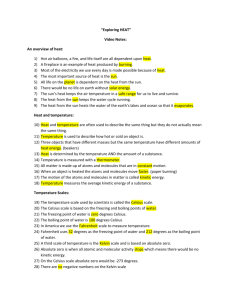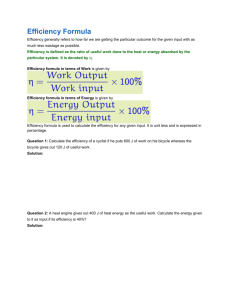Greenhouse Design contains thermal performace calculations
advertisement
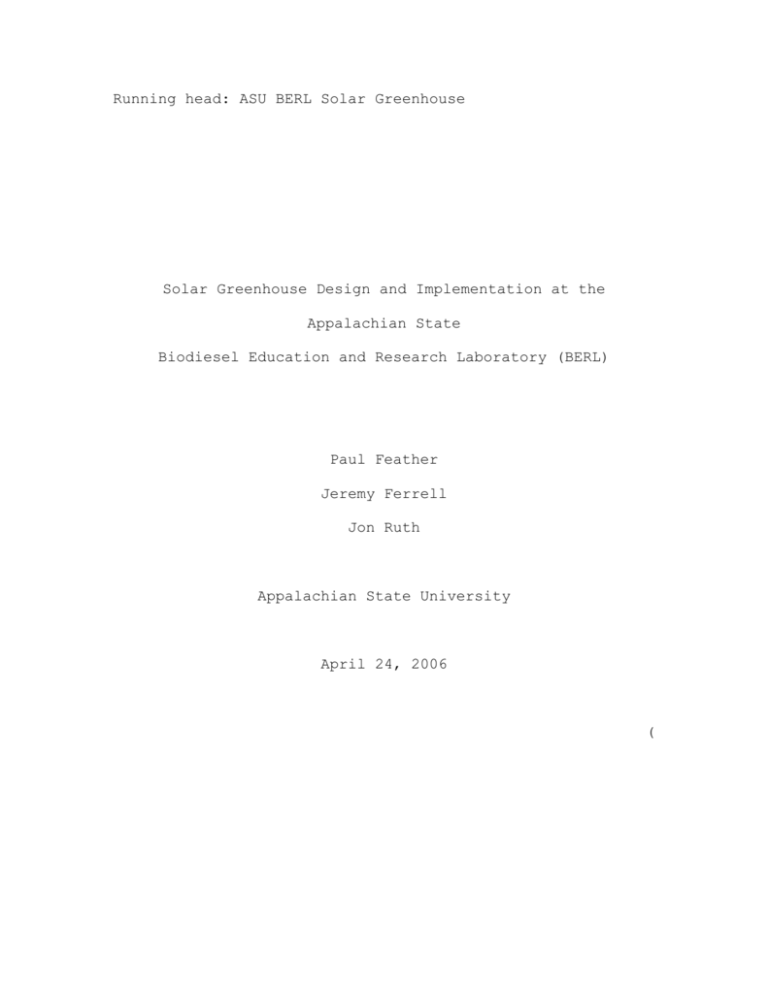
Running head: ASU BERL Solar Greenhouse Solar Greenhouse Design and Implementation at the Appalachian State Biodiesel Education and Research Laboratory (BERL) Paul Feather Jeremy Ferrell Jon Ruth Appalachian State University April 24, 2006 ( I. Background The overall goal of this research project is to design and implement a solar greenhouse capable of maintaining a sufficient ambient temperature independent of external heating. The greenhouse will rely solely on the sun’s energy for heating to house a variety or biological components; both plant and animal that will be incorporated into a biological remediation system or ecological machine that will treat wastewater in the processing of biodiesel. The construction of this greenhouse utilizes appropriate building technologies and will provide testing opportunities for building materials, high transmissivity glazing, solar gain, heat losses, air exchange, etc. The greenhouse is 14 x 20ft (280ft2) and is insulated on all sides except the south, where solar gain will be transferred as heat. Upon completion, a data logging system will be installed to record temperature and humidity inside the greenhouse. This solar greenhouse falls under a larger project, the ASU Collaborative Biodiesel Project. This is a student led initiative whose goal is to bring biodiesel production technology to Appalachian State. The project was spawned from an EPA-P3 grant that is a national student design competition relating to the pillars of sustainability, People, Planet and Prosperity. Appalachian State is one of forty-one Universities that has received an initial grant for design and implementation. In May 2006, the ASU Collaborative Biodiesel Project will travel to Washington DC to present the project’s innovation, technical merit, measurable results, evaluation method and implementation strategy. The top five projects will be awarded $75,000 for expansion and implementation of the project. Due to our original design and multidisciplinary focus, we feel that Appalachian will be a top contender in the competition. The multidisciplinary group includes graduate and undergraduate students from Technology, Chemistry, Biology, and Interdisciplinary Studies. One of the facets of our unique design is the incorporation of a biological remediation facility to treat wastewater from biodiesel processing. The concept of “closed-loop design” is a cornerstone philosophy of the collaborative and the incorporation a passive solar greenhouse, accentuates the theme of holistic design. The resultant success of this project is the creation of the Appalachian State Biodiesel Education and Research Laboratory (Appstate BERL). This facility, designated for biodiesel education and research, will enhance the opportunities of future ASU students from a wide variety of disciplines. II. Design III. Budget and Materials Quantity 8 4 2 4 2 2 1 4 1 2 36 18 14 17 40 3 20 15 1 24 12 Description 4"x4"x12' PT Posts 2"x8"x16' PT 2"x8"x14' PT 2"x8"x12' PT 2"x8"x8' PT 2"x4"x16' PT 2"x4"x14' PT 2"x4"x12' PT 2"x4"x8' PT 2"x4"x16' 2"x4"x10' 2"x4"x8' 2"x10"x12' Rafters 3/4" blueboard R4 2" blueboard R10 Poly carbonate glazing 3/8" plywood sheet 15/32 4ply shtg ext. 200^2 Ft. Roof Felt Great Stuff foam spray 29 GA Metal Roof Cost Ea. $14.97 $12.38 $13.20 $8.58 $7.10 $9.37 $7.68 $6.23 $3.68 $7.67 $4.11 $3.29 $15.46 $11.36 $25.00 $300.00 $12.99 $13.96 $13.98 $4.00 $12.98 Cost Total $119.76* $49.52 $26.40 $34.32 $14.20 $18.74 $7.68 $24.92 $3.68 $15.34 $147.96 $59.22 $216.44* $193.12 $1,000.00** $900.00* $259.80* $209.40 $13.98* $96.00* $155.76* Total 3,566.24 Additional items: Fasteners Gravel Concrete Fans, Pumps, Vents, Ducts Differential controller $900 $100* $100 $200 $80 Total $1,480 Grand Total 5,046.24 *Items received as donations from the university **Insulation salvaged from local construction waste Table 1. Greenhouse Materials List Budget IV. Thermal Performance Calculations A. Envelope Heat Loss 1. Foundation Perimeter heat loss = 70ft 20.5ft + 20.5ft + 14.5ft + 14.5 ft = 70ft (.23BTU/ft-hr-ºF) x (70ft) x (24hr/day) = 386 BTU/DD 2. East & West Walls heat loss Sect. 1: 2.7ft x 10.5ft = 14.2ft2 Sect. 2: 10.5ft x 7.75ft = 81.4ft2 Sect. 3: .5(7.75ft x 4ft) = 15.5ft2 = 111ft2 Sect. 4 (Bottom): .75ft x 14.5ft = 10.9ft2 Wall (R25) = 111ft2/ (25ft2-hr-ºF/BTU) x 24hrs/day = 107BTU/DD Bottom (R12) = 10.9ft2/12ft2-hr-˚F/BTU) x 24hrs/day = 21.8 BTU/DD East & West Walls = 258 BTU/DD 3. North Wall (R25) 11.5ft x 20.5ft = 236ft2 236ft2/25ft2-hr-ºF/BTU) x24hrs/day = 226 BTU/DD 4. Roof (R32) 20.5ft x 10.8ft = 221ft2 221ft2/32ft2-hr-ºF/BTU) x 24hrs/day = 166 BTU/DD 5. South Facing Glazing (2 wings –R25) 1.6ft x 8ft = 12.7ft2 (2) = 25.6ft2 (Wood- R7) .75ft x 20.5ft = 15.4ft2 (Polycarbonate- R2.7) 8ft x 18ft = 144ft2 (2 wings) 25.6ft2/25ft²-hr-ºF/BTU) x 24hrs/day = 24.6 BTU/DD (Wood) 15.4ft2/7ft²-hr-ºF/BTU) x 24hrs/day = 52.8 BTU/DD (Polycarbonate) 144ft2/2.7ft²-hr-ºF/BTU) x 24hrs/day = 1280 BTU/DD Grand total of South Face = 1375 BTU/DD 6. Total Theoretical Envelope Heat Loss 386 BTU/DD + 258 BTU/DD + 226 BTU/DD + 166 BTU/DD + 1357 BTU/DD = 2393 BTU/DD B. Solar Gain Calculation Table 1 – Average and Maximum Insolation Data for NC in January Angle 60º Avg. insolation (BTU/day/ft2) Max. insolation (BTU/day/ft2) 810 1215 1. Area of Glazing: (8ft x 18ft) = 144ft2 2. The triple wall polycarbonate glazing on our greenhouse has a transmission coefficient of 0.71, which yields: Average transmission: 810 BTU/day/ft2 x 144ft 2x 0.71 = 82,814 BTU/day Maximum transmission: 1215 BTU/day/ft2 x 144ft2 x 0.71 = 124,221 BTU/day 3. Heat Absorbed by Thermal Mass If our thermal mass absorbs 40% of the incident solar radiation calculated above, our greenhouse would store: 82,814 BTU/day x .4 = 33,126 BTU/day on an average day 124,221 BTU/day x .4 = 49,689 BTU/day maximum. If our thermal mass absorbs 40% of the incident solar radiation calculated above, our greenhouse would store: Average: 82,814 BTU/day x .6 = 49,688 BTU/day on an average day Maximum: 124,221 BTU/day x .6 = 74,533 BTU/day maximum. C. Gain from Solar Thermal System There will be 200 gallons of oil, and 350 gallons of water storage in the greenhouse that are actively heated by our solar thermal system. We have measured the solar thermal system to produce a peak power of 10,200 btu/hr, and estimate that we can get 40,000 btu/day in sunny weather. A sample of the data we have collected is shown in the following graph: 9:00 3:00 9:00 3:00 9:00 3:00 9:00 3:00 9:00 3:00 AM PM PM AM AM PM PM AM AM PM Time of day ambient hot water processor We can add energy from our solar thermal system into the energy balance estimating greenhouse performance, below. D. Envelope Loss vs. Solar Gain Minimum heat gain: 1. 33,126 btu/day + 40,000 btu/day = 73,126 Btu/day 2. 73,126 Btu/day x 1/2,393 Btu/DD = 31ºF Average heat gain: 1. 49.688 btu/day + 40,000 btu/day = 89,688 Btu/day 2. 89,688 btu/day x 1/2392 Btu/DD = 37ºF Maximum heat gain: 1. 74,533 btu/day + 40,000 btu/day = 114,533 Btu/day 2. 114,533 btu/day x 1/2392 Btu/DD = 48ºF Thus, with the aid of directly heated thermal mass, our greenhouse should maintain a temperature difference of between 30 and 48ºF between its interior and the ambient air temperatures. V. Ventilation & Moisture Temp (F) 190 170 150 130 110 90 70 50 30 The housing of an ecological-machine inside our solar greenhouse will make for a high humidity environment. The evaporation from these open water tanks could lead to moisture problems in the building. The goal is to achieve venting requirements with DC fans that powered by a 24-volt battery and photo-voltaic system. In-take vents will be located near the ground on the east and west walls. Exhaust vents and fan will be located above the door on the north wall. We have selected a 24 volt 16” Venturi Fan 1800 CFM (2005 Renewable Energy Design & Catalog). In case of extreme moisture problems, we are considering enclosing the open water tanks with small polyethylene hoop dome. This enclosure could have its own airintake and exhaust to remove excess moisture from the building while providing carbon dioxide rich air for increased photosynthesis. VI. Construction log & Photo Documentation The purpose of this log is to show the timeline of on the ground construction and calculate number of hours invested in labor. Note: all labor is student labor and has been volunteered. Construction Log: (January -April 2006) ASU BERL Solar Greenhouse Week of Jan. 1 Jan. 8 Jan. 15 Jan. 22 Jan. 29 Feb. 5 Feb. 12 Feb. 19 Feb. 26 Mar. 5 Mar. 12 Mar. 19 Mar. 26 April 2 April 9 April 16 Primary Task Footer dug(backhoe), sump pump dug Set Quickset tubes/posts & backfill concrete for columns (1 cubic yard) insulate foundation & columns, spread gravel, begin framing gravel, frame back wall, doors Beams constructed, plumbing ditch, framing, dumpster blue board,begin insulation Rafters, bird blocking, insulation Roof, bird blocking, sheating, insulation Roof-tar paper, tin, prime outside, gravel Insulation, walls & roof, paint Insulation, tin roof fastening Spring Break GH work week fur-out walls, insulate ceiling, doors, panel interior Paint exterior (top-coat) Insulation, stafters cut and installed Install Glazing Raised beds built, interior paint primer Finish interior, hang doors Total Hours Estimated Hours 25 24 35 36 30 40 50 35 15 10 60 10 20 20 15 25 450 VII. Summary & Conclusions The design and implementation of this solar greenhouse has proved to be an incredible learning opportunity for members of this team and the larger collaborative. The grassroots nature of this construction project has given over 30 students’ valuable hands-on experience, transcending classroom theory into practical applications. We are proud to have built this greenhouse in less than four months, while handling all logistical details. Tasks have included organizing and supervising volunteers, budgeting funds from several accounts, and purchasing materials. Teamwork has been integral in every step of this project from design to implementation of advanced building techniques. We have yet to test our greenhouse performance but feel confident that it will supply sufficient heating for the ecological machine.
